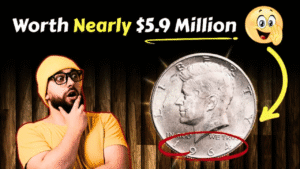Ever glance at the quarters in your wallet and wonder if they’re worth more than 25 cents? The 1976 Bicentennial Washington Quarters, minted to celebrate America’s 200th birthday, might surprise you. Featuring George Washington on the front and a colonial drummer boy on the back, most of these coins are common.
But a few rare varieties and errors are worth thousands—or even tens of thousands! Some are still floating around in circulation, hiding in change jars or cash registers. Here’s a rundown of the top six most valuable 1976 Bicentennial Quarters to look for, based on recent auction sales. Grab a magnifying glass and start hunting—you could be holding a fortune!
Why Are 1976 Bicentennial Quarters Special?
In 1975 and 1976, the U.S. Mint produced over 1.6 billion Bicentennial Quarters to mark America’s 200th anniversary of independence. With a unique “1776-1976” dual date and a drummer boy reverse designed by Jack L. Ahr, these coins were a hit.
Most are copper-nickel clad and worth face value, but rare silver versions, minting errors, and pristine conditions make some incredibly valuable. Collectors love their historical significance, and certain coins fetch jaw-dropping prices at auction.
Top 6 Most Valuable 1976 Bicentennial Quarters
Here are the six rarest and most valuable 1976 Bicentennial Quarters that could still be in circulation. Check your coins for these treasures!
1. 1976-S Silver Bicentennial Quarter (MS69 Grade)
Unlike standard copper-nickel clad quarters, this San Francisco-minted coin contains 40% silver and was made for collector sets. Some slipped into circulation when sets were broken up. In near-perfect MS69 condition, one sold for $19,200 at auction. Look for the “S” mint mark under Washington’s neck and a flawless, shiny surface. Weigh it—silver versions are heavier at 5.75 grams compared to 5.67 grams for clad.
2. 1976-S Silver Proof Bicentennial Quarter
Proof coins, designed for collectors, have a mirror-like finish and sharp details. This 40% silver proof from San Francisco fetched $13,500 in 2019, even in a lower PR25 grade, due to its rarity. Check for the “S” mint mark and a frosted design against a reflective background. These coins rarely enter circulation but can appear when collector sets are opened.
3. 1976 Bicentennial Quarter Overstruck on a Dime Planchet
This rare error occurs when a quarter design is struck on a smaller dime blank, creating a coin that’s too small and lightweight (around 2.27 grams). One in proof condition sold for $12,000. Look for a quarter that seems undersized with incomplete or misaligned designs. These errors are like finding a needle in a haystack but could be hiding in your change.
4. 1976-D Clad Doubled Die Obverse (DDO) Quarter
A doubled die error happens when the minting die imprints the design twice, slightly offset, causing a blurry effect on Washington’s portrait, “LIBERTY,” or the “1776-1976” date. This Denver-minted (D mark) clad quarter in MS66 condition sold for $8,400. Use a magnifying glass to spot doubling. Since these were made for circulation, they’re prime candidates to find in everyday change.
5. 1976-D Clad Bicentennial Quarter (MS68 Grade)
A regular Denver-minted clad quarter, but in near-perfect MS68 condition, sold for $6,463. Most circulated quarters show wear, but this one’s pristine state makes it rare. Check for the “D” mint mark, sharp drummer boy details, and no scratches or dings. These high-grade coins are tough to find after decades in circulation but are still out there.
6. 1976 Clad Bicentennial Quarter (MS67+ Grade)
Minted in Philadelphia (no mint mark), this clad quarter in exceptional MS67+ condition fetched $1,821 at auction. Its value lies in its near-perfect preservation—crisp edges, full luster, and no wear. These coins were mass-produced, so finding one in such great shape is rare but possible in pocket change or old collections.
How to Spot a Valuable 1976 Bicentennial Quarter
Think you’ve got a rare quarter? Here’s how to check:
- Confirm the Date: Look for the “1776-1976” dual date on the front.
- Check the Mint Mark: Find it under Washington’s neck— “S” for San Francisco, “D” for Denver, or no mark for Philadelphia.
- Weigh the Coin: Silver quarters (5.75 grams) are heavier than clad (5.67 grams). Use a precise scale.
- Look for Errors: Use a magnifying glass to spot doubled die errors (blurry text or portrait) or odd sizes (like a dime planchet).
- Examine Condition: Pristine coins with no wear or scratches are worth more. Look for sharp details and luster.
- Avoid Cleaning: Cleaning damages the coin’s patina and lowers its value.
For confirmation, get your coin graded by trusted services like PCGS or NGC to verify authenticity and condition.
Value Table for 1976 Bicentennial Quarters
Here’s a quick reference for the approximate values of these rare quarters:
| Type/Variety | Grade | Approximate Value |
|---|---|---|
| 1976-S Silver Bicentennial (Uncirculated) | MS69 | Up to $19,200 |
| 1976-S Silver Proof | PR25 | Up to $13,500 |
| 1976 Overstruck on Dime Planchet | Proof | Up to $12,000 |
| 1976-D Clad Doubled Die Obverse | MS66 | Up to $8,400 |
| 1976-D Clad Bicentennial | MS68 | Up to $6,463 |
| 1976 Clad Bicentennial (Philadelphia) | MS67+ | Up to $1,821 |
Tips for Coin Collectors
New to coin hunting? Here’s how to maximize your chances of finding a valuable Bicentennial Quarter:
- Check Your Change: Always inspect quarters in your wallet, change jars, or at the store for the “1776-1976” date.
- Protect Your Coins: Store them in acid-free plastic sleeves or coin flips to prevent scratches or moisture damage.
- Learn to Spot Errors: Familiarize yourself with doubled die or planchet errors using resources like PCGS or coin collecting forums.
- Get Professional Grading: Authentication by PCGS or NGC boosts a coin’s value and credibility.
- Sell Smart: High-value coins sell best at auction houses like Heritage Auctions or Stack’s Bowers. For common coins, try eBay or local coin shops.
Pro Tip: Handle coins with gloves or tweezers to avoid fingerprints, and never clean them, as it reduces their value.
Real-Life Examples of Big Sales
- 1976-S Silver MS69: Sold for $19,200 due to its perfect condition and 40% silver content.
- 1976-S Silver Proof PR25: Fetched $13,500 in 2019, showing even lower-grade proofs can be valuable.
- 1976-D Clad DDO MS66: Brought $8,400, highlighting the demand for error coins.
Could Your Quarter Be a Hidden Gem?
The 1976 Bicentennial Washington Quarter is more than just pocket change—it’s a piece of American history with the potential for massive value. While most are worth 25 cents, finding a silver version, a minting error, or a pristine high-grade coin could net you thousands. So, dig through your change, check old coin collections, or peek in grandma’s piggy bank. Your next quarter might just be worth a small fortune! Always consult a professional grader for authentication to ensure you get top dollar.
FAQs About 1976 Bicentennial Quarters
Q: Why are some 1976 Bicentennial Quarters so valuable?
A: Rare varieties like 40% silver coins, minting errors (e.g., doubled die or wrong planchet), and pristine high-grade conditions drive their value, with some fetching up to $19,200.
Q: How can I tell if my 1976 quarter is silver?
A: Look for an “S” mint mark and weigh it—silver quarters are 5.75 grams, heavier than clad (5.67 grams). Silver coins lack a copper stripe on the edge.
Q: What is a doubled die obverse (DDO) quarter?
A: It’s an error where the design is stamped twice, causing a blurry effect on text or Washington’s portrait. A 1976-D DDO sold for $8,400.
Q: Can I still find valuable 1976 quarters in circulation?
A: Yes, though rare, silver versions and error coins can still appear in pocket change or old collections.
Q: Where can I sell a rare 1976 Bicentennial Quarter?
A: High-value coins sell best at auction houses like Heritage Auctions or Stack’s Bowers. Common coins can go to local coin shops or eBay.
Q: Should I clean my quarter to increase its value?
A: No, cleaning damages the coin’s surface and lowers its value. Keep it untouched and get it professionally graded.




